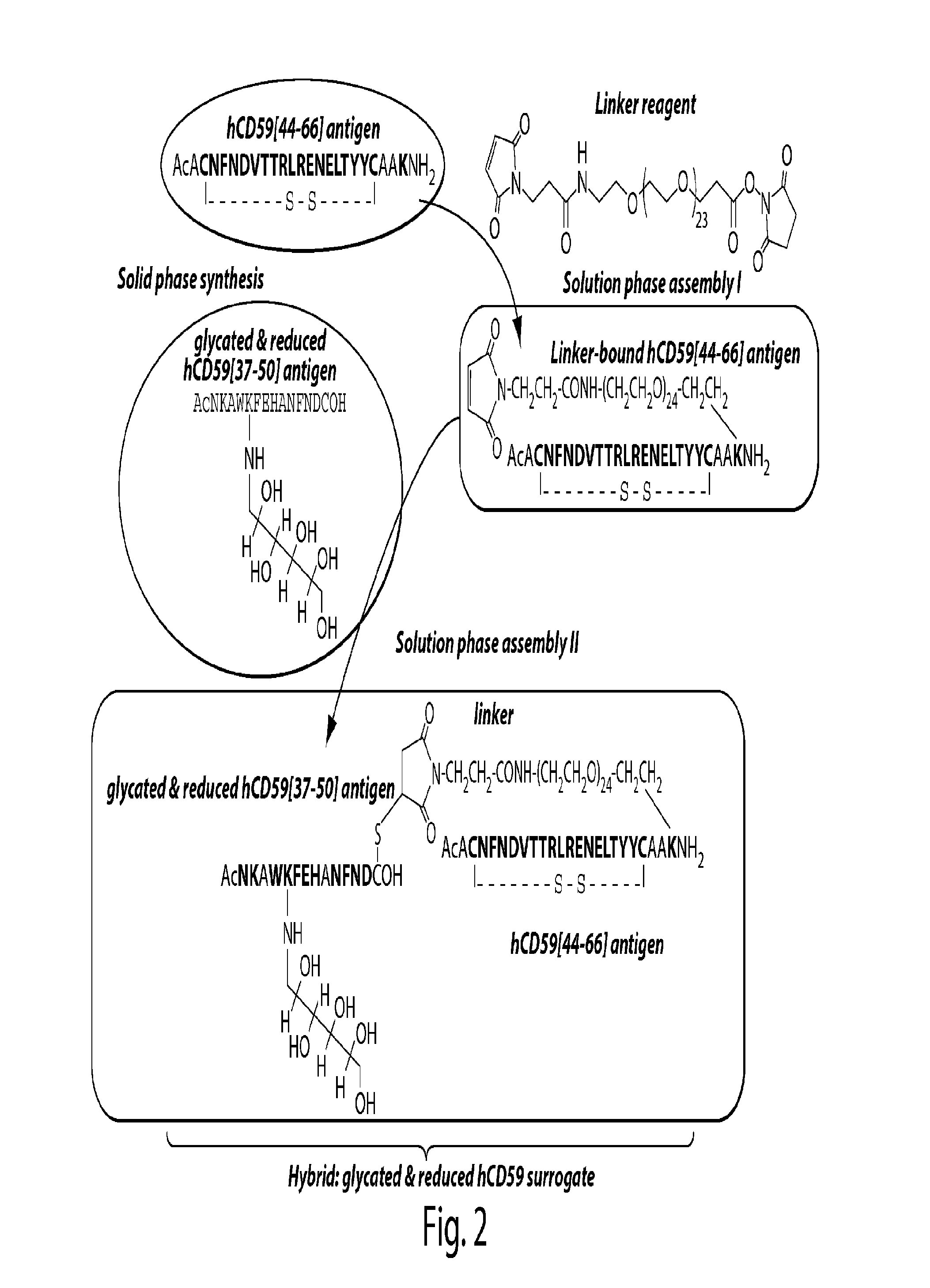Surrogates of post-translationally modified proteins and uses thereof
a technology of post-translational modification and surrogates, which is applied in the field of surrogates of post-translational modified proteins, can solve the problems of morbidity and mortality in the adult population, impede or prevent the convenient analysis of ptm proteins, and the unmet need to obtain synthetic constructs
- Summary
- Abstract
- Description
- Claims
- Application Information
AI Technical Summary
Benefits of technology
Problems solved by technology
Method used
Image
Examples
example 1
[0264]General peptide coupling procedures for the stepwise solid-phase polypeptide synthesis of derivatives of such as Nα-Ac[Lys41(Nε-1-deoxyfructosyl)] human CD59(37-50)-OH. The above-indicated polypeptide was manually synthesized from 155 mg of Fmoc-Cys(Trt)-Rink resin starting material (0.41 meq / g, 0.0633 mmol) using PyBOP, HOBt, and DIEA coupling reagents in 5 / 5 / 10-fold molar excess. Successive N′-Fmoc protected amino acids were added in a 5-fold molar excess and stirred 2-3 hours at ambient temperature in the dark. Side-chain protecting groups of the N′-Fmoc protected amino acids included: Asn(Trt), Asp(OtBu), Glu(OtBu), His(Nim-Trt), Lys(Nε-Boc) and Trp(Nin-Boc).
example 2a
Synthesis of 2-(9H-Fluoren-9-ylmethoxycarbonylamino)-6-(2,3,4,5,6-pentahydroxy-hexylamino)-hexanoic acid [Fmoc-Lys(gluc)-OH]:[Nα-Fmoc-N-(1-deoxy-D-glucitol-1-yl)-L-lysine] (1)
[0265]A solution of Nα-Fmoc-L-lysine (1.84 g, 5 mmol) and sodium cyanoborohydride (378 mg, 6 mmol), in THF / H2O (50 / 50 v / v, 30 mL) at pH 7.0 (adjusted with 0.1 N HCl) was mixed with an aqueous solution (2.5 mL) of D-glucose (2.7 g, 15 mmol). The mixture was stirred for 72 h at 37° C., then concentrated under vacuum. The pure compound was obtained as a powder (2.29 g, 55%) after purification by RP C-18 silica gel chromatography using a gradient of 0-30% of solvent A in B (A=0.1% AcOH in acetonitrile; B=0.1% AcOH in H2O; Flow rate=15 mL / min). Rt=10.10 min (gradient 10% to 60% in 25 min). MS+(ESI) m / z 533.29 ([M+H]+), calcd: 532.24 (M+). m.p.: 90-92° C. 1H-NMR (DMSOd6, 400 MHz): 7.88 (d, J=7.6, 2H), 7.69-7.71 (m, 2H), 7.41 (t, J=7.6, 2H), 7.32 (t, J=7.6, 2H), 4.19-4.28 (m, 5H), 3.84-3.94 (m, 2H), 3.58 (m, 1H), 3.38...
example 2b
Synthesis of 6-[tert-Butoxycarbonyl-(2,3,4,5,6-pentahydroxy-hexyl)-amino]-2-(9H-fluoren-9-yl-methoxycarbonylamino)-hexanoic acid: {Nα-Fmoc-Lys[Nε-Boc-Nε-(1-deoxy-D-glucitol-1-yl)]} (2)
[0266]A solution of (1) (1.34 g, 2.5 mmol) in 10% TEA in methanol was treated with di-tert-butyl-dicarbonate (1.15 mL, 5 mmol), in presence of few drops of H2O to achieve complete solubility, was stirred at room temperature for 16 h. The residue obtained after concentration under vacuum was purified by RP C-18 silica gel chromatography using a gradient of 0-50% of solvent A in B (A=acetonitrile; B=H2O; Flow rate=15 mL / min). The pure product was obtained after lyophilization as a white powder (1.49 g, 95%). Rt=20.05 min (gradient 10% to 60% in 25 min). MS+(ESI) m / z 632.92 ([M+H]+), calcd: 632.29 (M+). m.p.: 78-80° C. 1H-NMR 7.86 (d, J=7.5, 2H), 7.69 (d, J=7.2, 2H), 7.40 (t, J=7.2, 2H), 7.30 (t, J=7.5, 2H), 4.18-4.26 (m, 3H), 3.31-3.56 (m's, 9H), 3.09-3.27 (m, 4H), 1.40 (m, 2H), 1.33 (s, 9H), 1.20-1.26 (...
PUM
 Login to View More
Login to View More Abstract
Description
Claims
Application Information
 Login to View More
Login to View More - R&D
- Intellectual Property
- Life Sciences
- Materials
- Tech Scout
- Unparalleled Data Quality
- Higher Quality Content
- 60% Fewer Hallucinations
Browse by: Latest US Patents, China's latest patents, Technical Efficacy Thesaurus, Application Domain, Technology Topic, Popular Technical Reports.
© 2025 PatSnap. All rights reserved.Legal|Privacy policy|Modern Slavery Act Transparency Statement|Sitemap|About US| Contact US: help@patsnap.com



